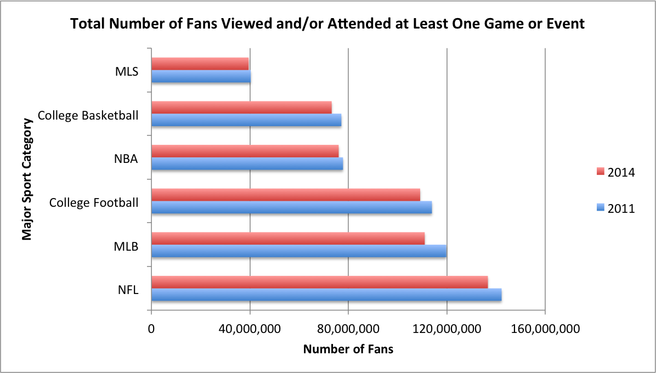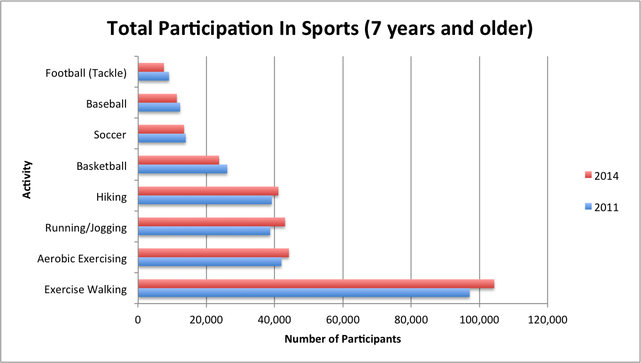Since 2011, fans that view or go to a traditional sports game has been decreasing or staying relatively the same. Major League Baseball and the National Football League have both experienced the most significant decreases in participation with an average loss of about 8,000 fans from 2011. Major League Soccer and the National Basketball League attendance decreased slightly but not significantly. Collegiate basketball and football also saw a slight decrease. Many possible factors could be cited as a cause of this decline, but one uncommon factor stands out in recent data. Participation in traditional sports by the average American has been decreasing since 2000.

Basketball, baseball, and football have especially seen significant decreases in participation. In the graph below, data shows a decrease from 2011 to 2014 in all of these traditional sports and a stagnation of participation in soccer. Many might attribute this decrease to an increasing interest in video games, social media, and other technological activities. However, the data also shows an interesting spike in other athletic activities relating to fitness and health. Exercise walking, aerobic exercising, running, and hiking have all increased around 20% since 2000. From 2011 to 2014, the graph shows an increase in all of these activities mirroring the increasing national trend of healthy living.

The Sports & Fitness Industry Association (SFIA) released an annual report outlining a persistent trend of participation in fitness activities such as aerobics and conditioning supporting the trend of healthy lifestyles. Cardio Cross Training and High Impact Aerobics grew enormously in participation levels in 2014. Tom Cove, SFIA’s CEO & President, explains the popularity of these sports-related activities, “The limited time needed to take part in these workouts and tremendous health benefits they provide is truly a win-win situation for the fitness community.”
Nike, the leading athletic wear brand, has used this trend of healthy living to their advantage. In a recent commercial for Nike+ Run Club, Nike targets the average consumer who strives to have a healthier lifestyle but struggles in the back of the pack. This targeted ad reaches out to individuals and entices them to join this healthy lifestyle. And ads like these are working. Nike reported earnings have risen 22.6% in the first quarter of 2015. All of Nike’s product sectors increased except sports equipment. Footwear gained the largest leap with an 18% increase in sales.
So why would people who live a healthy lifestyle stop playing sports? The key to this issue is the word “lifestyle.” People are choosing to run or participate in aerobics over a recreational basketball league. They find teamwork in running clubs and classes at the gym. Other individuals not consumed in a healthy lifestyle chose to spend their always-shrinking free time on other activities. These circumstances leave a declining participation rate in sports. With a lower participation rate in sports, people become less invested in their favorite sport, which directly correlates to fan viewing and attendance. Professional and collegiate sports should consider trying to integrate trends in health to increase attendance and sports participation.
This blog post was written by Samford University student Mary Kate Thomas.
Sources
(2015, September) Nike Crushes Earnings Expectations. Sports Executive Weekly.
(2015, August) SFIA: Intense Aerobic Workouts Fuel Growth In Fitness Participation. SGB Update.
www.SBRNet.com for participation and attendance figures and tables
